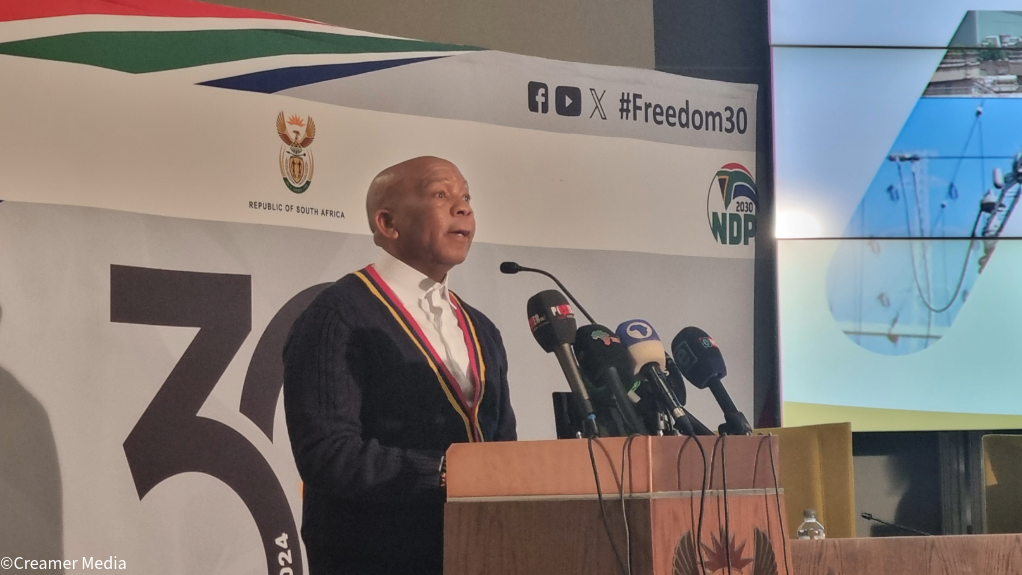Despite Eskom having made progress on improving the country’s energy availability factor (EAF), lowering the unplanned capacity loss factor (UCLF) and achieving 100 consecutive days without loadshedding on July 5, the country is facing a new kind of energy crisis, Electricity and Energy Minister Dr Kgosientsho Ramokgopa has said.
In his first briefing for the now standalone ministry on July 8, the Minister warned that municipalities were investing too little on infrastructure maintenance and modernisation, with some having mismanagement issues, resulting in costly issues on the distribution side.
Not only are certain municipalities implementing load reduction, leaving various households without constant supply of electricity, but tariff hikes are causing energy poverty in poor households.
Ramokgopa elaborated that household finances were increasingly under pressure, with customers unable to afford rising electricity costs. Some households were opting to buy food instead of electricity, which, in turn, meant municipalities were generating less revenue.
He told attendees of the Ministry’s inaugural briefing that South Africa’s electricity distribution industry was heading for self-destruction and that it would increasingly become a liability for the economy.
With municipalities owing R78-billion in arrear debt to Eskom as of end-May, Ramokgopa said these arrears would worsen to more than R3-trillion by 2050 if no urgent interventions were made.
The increasing number of people unable to afford electricity is also a focal point for the Ministry as it undertakes a review of the electricity tariff model.
“The electricity pricing structure is eroding the income base of municipalities and increasing the cost of living for all households – for some to unaffordable levels.”
The Minister added that government would finalise a funding model to mitigate municipal revenue loss through distribution reforms and the uptake of renewable-energy options for large power users, as well as a reviewed electricity tariff model to enhance affordability.
The Department of Electricity and Energy is working on an electricity distribution industry restructuring roadmap, in collaboration with municipalities, the South African Local Government Association and other government departments such as Cooperative Governance and Traditional Affairs to determine viable solutions to address municipal mismanagement, debt reduction and inadequate infrastructure investment.
Further, Ramokgopa foresees the possibility of an “unprecedented scale” of bid windows to be rolled out for the procurement of renewable energy. He referred to these as “mega bid windows” and said it would accelerate renewable-energy development in the country, which should contribute to the modernisation of the distribution industry, improved energy affordability and universal access for all citizens.
He added that the distribution industry would undergo more modernisation through smart meter installation, flexible grids, demand side solutions and increased efficiency to arrest the escalating municipal debt issue and to bring down costs for consumers.
The Minister noted one major issue as being that of non-ringfenced investment for electricity infrastructure in many municipalities, which renders unmaintained systems vulnerable to failure, damage and technical losses.
“Distribution has both a commercial mandate to ensure economic growth and a social mandate to provide affordable energy to alleviate energy poverty,” Ramokgopa stated.
Meanwhile, he lauded Eskom for having improved the year-to-date EAF to 61.5%, compared with 54.5% in the same period of last year. This while the UCLF has been reduced to 27% in the year-to-date, compared with 34.9% in the same period of last year.
The country had 17 000 MW in unplanned capacity losses this time last year, which Eskom has improved to 12 000 MW through generation recovery efforts at its coal-fired power stations.
For context, loadshedding typically starts becoming necessary to protect the grid when unplanned capacity losses reach 14 000 MW.
Moreover, Eskom spent R6.2-billion less on open-cycle gas turbine diesel expenditure in the year-to-date, compared with the same months of last year.
Ramokgopa assured stakeholders at the briefing that diesel was not anchoring the electricity generation performance in the country; rather, he attributed the generation recovery to the efforts of Eskom’s engineers and the effectiveness of the Energy Action Plan and its implementation since being launched in July 2022.
EMAIL THIS ARTICLE SAVE THIS ARTICLE ARTICLE ENQUIRY
To subscribe email subscriptions@creamermedia.co.za or click here
To advertise email advertising@creamermedia.co.za or click here











